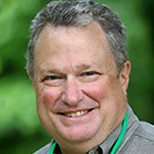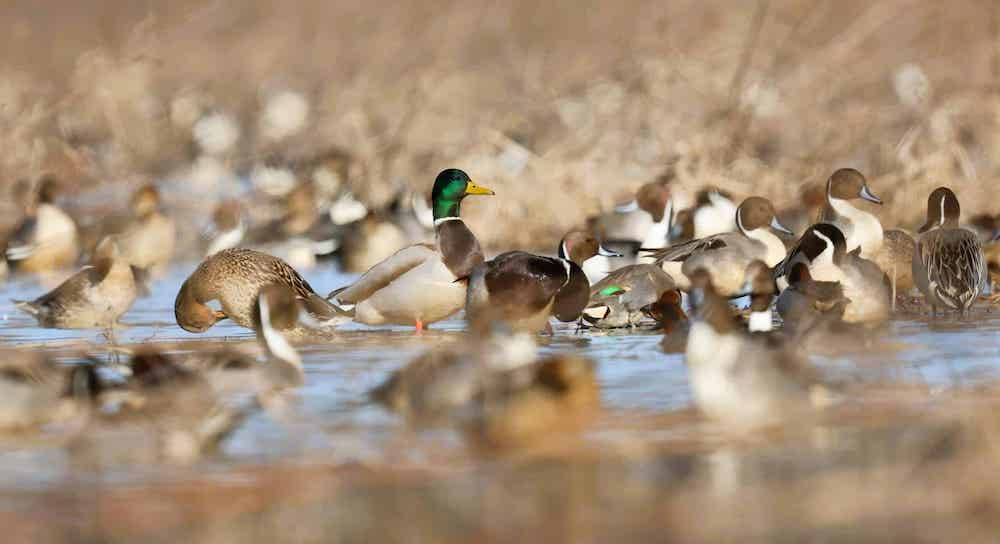Waterfowl hunters can return to hunting 30 minutes before sunrise on Saturday, Dec. 9, throughout Arkansas as the state’s 60-day season resumes pretty much like it left off: mostly dry conditions and not a lot of ducks around.

By Jim Harris
Managing Editor Arkansas Wildlife Magazine
We’re going to learn just how many ducks have been camped out around the state this week in a few days, however, when the Arkansas Game and Fish Commission releases its annual December Waterfowl Aerial Survey of the state. Four AGFC biologists went airborne this week to count ducks (and take note of geese) in the Delta region, the Arkansas River Valley and in southwestern Arkansas. Their data will be studied before AGFC Waterfowl Program Coordinator Brett Leach puts out the results.

Leach said Tuesday that from Monday’s flying by some of the team, “it sounds like there were a couple hot spots but pretty bleak otherwise.” This did not include any flying in the middle and southern portions of the Delta, though, which came later this week. And we can report anecdotally that on the second Saturday of the first second of the season, hunting in southern Arkansas County, it appeared a few large groups of mallards had descended into that portion of the state.
Dry conditions (that is, no snow or ice coverage of food sources) above Arkansas have a lot to do with lack of movement of waterfowl in Arkansas to this point, biologists note. Then, when ducks arrive here, there are not a lot of choice wet areas for the waterfowl to spend their stopover time.
Biologist Alex Zachary, part of the survey team and based in the Arkansas River Valley, flew on Monday and told us the numbers he saw “were marginal at best.”
“Most of the ducks we did see were utilizing more permanent bodies of water such as lakes, reservoirs, stock ponds and oxbows. It’s fairly typical for early in the season and with dry conditions. That being said, we have seen moderate duck use on Ed Gordon (Point Remove WMA). Hunting pressure plays a part in that where they are there one day, gone the next.”
The good news is that the public hunting areas with access to water to flood the moist-soil units and greentree reservoirs are seeing an uptick in water levels. Last Thursday’s heavy rainfall (about 2 inches in Central Arkansas, for example) didn’t hurt. But weather forecasts don’t indicate a lot of rain coming, outside of Saturday.
The second portion of Arkansas’s season will run until sunset Saturday, Dec. 23, before resuming for the final portion on Wednesday, Dec. 27, and concluding Jan. 31.
Ed Gordon Waterfowlers Benefit From Longtime Efforts by AGFC
What had to have stood out to anyone taking note of the habitat conditions and water levels in public hunting areas of Arkansas the first two weekends of the waterfowl season was the water coverage in most of the units of Ed Gordon Point Remove WMA. Having ample hunting water and enough for waterfowl usage can be traced to the infrastructure work that’s been done on Ed Gordon dating to 2014 and a huge project that involved Southwestern Energy and Ducks Unlimited with the AGFC.
“That was a multifaceted project,” Alex Zachary, biologist at Ed Gordon Point Remove WMA, said. “But really the big thing that allowed us to be able to have some water, particularly early this season, was the installation of the new pump station.”
Before the 200-horsepower pump station was built and seven miles of irrigation pipe laid, plus some grading and reshaping of the WMA’s moist-soil units, Ed Gordon Point Remove had five electric relift pumps to put water on the area.
“But how they were designed and where they were set, how they were set, (Point Remove Creek) had to be up and you had to have a good amount of rainfall before they were operational.”
Also, Zachary noted, the pumps were set up to discharge in only one or two locations, “whereas this new pump goes to pretty much every moist-soil impoundment we have, except for two and the waterfowl rest area. But it goes to probably 20 impoundments or close to it.”
The new pump and pipe installation, the brainchild of Buck Jackson, the AGFC’s state wetlands coordinator, was designed to either draw water from Point Remove Creek, or to pull water (that the AGFC would purchase) from the Point Remove Wetlands Reclamation and Irrigation District, which delivers its water through a series of flume ditches from the Arkansas River. The WMA sits mostly within that water district.
But, Zachary said, the AGFC did not have to purchase water for fall flooding this season.
Besides being able to draw water out of the creek and spread it among the units, the WMA benefited from the new pump in irrigating the moist-soil units throughout the summer. That meant more productive moist-soil for the migrating waterfowl (including blue-wing teal in September), helping the moist-soil community’s vegetation and the invertebrates on which waterfowl feed, and wetter soil during the hot and dry summer.
“Beginning with fall flooding, it allowed us to be more efficient with our water usage and allowed us to flood up more quickly because of the soil moisture that was there from irrigation that otherwise wouldn’t have been there at all,” Zachary said.
It’s not a race to flood the units to capacity, Zachary adds. Instead, it’s fine-tuned in a way to stagger flooding through the WMA. Some units will be taken to 30-60 percent of full pool at the beginning of the season, and then that water is moved to another unit. The biologists will come back with more water on each unit as they gradually bring the impoundments to full pool later in the season.
“The goal is twofold in that it spreads more water out over the landscape,” Zachary said. “That allows waterfowl and hunters to spread out and provide more opportunity and … as you stagger the flooding, it’s ensuring that you have new food and resources available for waterfowl going on throughout the wintering period, not just at the beginning.”
Because Ed Gordon had more water than other Arkansas public hunting areas, it had “quite a few folks” for opening weekend, Zachary said. But thanks to a new regulation this year, the WMA will have rest periods during the week: no hunting is allowed Monday, Wednesday and Friday.
Zachary said he noticed one difference at the WMA with the regulation change during the first nine days of the season. “Anecdotally, when we were checking water and pumps during an off day in the first part of the season, we were seeing ducks milling around the area at midmorning, which is not typically what you would have seen in previous years if folks were out hunting,” he said. “This change appears to be reducing disturbance and increasing waterfowl use of the area. We’ll see as the rest of the season continues.”
Always Plan Ahead on Permits
Now we’re in a regular pattern with Arkansas waterfowl hunting. Permits are being offered every weekend until the end of the 60-season. The only odd day out in terms of permits for both the Waterfowl Rice Incentive Conservation Easement program or the WMA permits hunts, whether for youth or adults where permits are required, will be Sunday, Dec. 24. Whereas weekends are usually open, there is no hunting on Christmas Eve; so, that Dec. 23-24 weekend will only have one hunting day available.
The rest of the season has no weekend day off. So jump on those available permits.
Just remember that to obtain a permit, hunters must apply this week to be able to hunt on the weekend of Dec. 16-17 (and on Wednesday at Sheffield Nelson Dagmar WMA’s permitted blinds, which are available to any age hunter that day but to youths on weekends). Application period begins at 3 p.m. Thursday and concludes at midnight Sunday. This includes the WRICE permit application. Winners of permits are notified on Monday.
All applications are $5. Hunters may only apply for one WRICE field per week. Visit the AGFC’s special permit page, which includes more information and a link for WRICE field permit applications and other permit areas, for more information or to apply.
Snow Geese Arrival
Hunters in Arkansas County and sporting goods stores in the area reported to the Waterfowl Report that the number of greater white-front geese seen this year was greater than they had seen in years. (As for the editor of the Waterfowl Report, he can remember when specklebellies were close to nonexistent in these parts, especially after Christmas; not so now). Similar reports passed this way from observers and hunters in Lonoke and Prairie counties as well.
In late October, just as the goose season opened, it was also noted how few snow geese were in the fields compared with specklebellies.
But that all seemed to change at the close of the first season. In the flooded fields on U.S. Highway 165 between Humphrey and Geridge, snow geese were assembled en masse. One of the large flooded fields was a veritable white blanket of geese from one end to the other. This proved true in fields from Stuttgart and on to DeWitt.
Although the AGFC’s aerial surveys of waterfowl have focused on duck counts (because ducks tend to stay in one place even while the planes fly overhead, while geese will scatter), the biologists have been providing some detail to the number of geese seen in recent years. We’ll be interested in seeing what kinds of numbers arise from the transects the biologists have flown this week.
Remember that for the rest of waterfowl season, the hunting of greater white-front geese, snow and blue geese, Ross’s geese and Canada geese follow the same dates as hunting for ducks, mergansers and coots. Hunting for specklebellies will end Jan. 31 along with ducks, mergansers and coots. Snows, blues and Ross’s geese can be hunting into the spring with the Light Goose Conservation Order, which begins Feb. 1.
Check the website for limits of each species during the regular waterfowl season.


